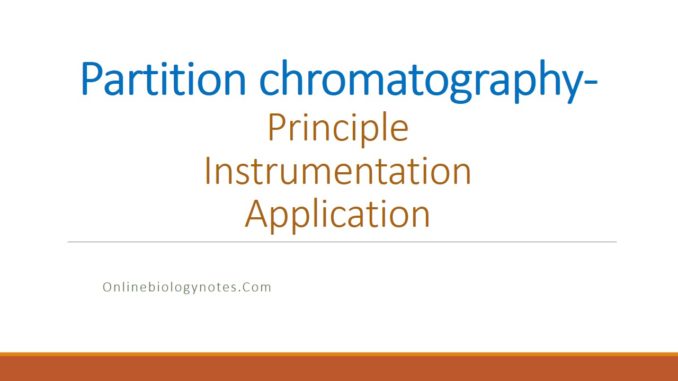
Introduction
- First developed by Martin and Syange in 1941, illustrated the technique for the separation of amino acids.
- Their basic was to use liquid phase that were mutually insoluble and as mobile and stationary phase.
- The stationary liquid phase was absorbed on the surface of a substrate.
- The amount of material involved was very small, so that a thin layer of adsorbed liquid was held in place on the surface of the substrate.
- A mobile liquid phase could flow over this stationary phase without removing it from the column.
- A sample was injected into the column in the normal fashion and distributed itself between the stationary phase and mobile phase according to the distribution coefficient.
- When the sample was in the mobile phase, it progressed down the column and eventually reached the detector.
- Separation of two samples is achieved when their distribution coefficients were different and therefore times spent in the mobile phase were different.
- Consequently, the elution times would be different and separation would be affected.
What is partition chromatography?
- Let us consider a column packed with a finely divided chemically inert solid substance, each particle of which is coated with a thin layer of liquid (the stationary phase).
- If the solution (the mobile phase) containing the component A and B is poured into the top of the column, each component will have an affinity for the liquid of the stationary phase and will have an affinity for the liquid of stationary phase and will have the tendency to dissolve in it.
- The relative attraction of each solute species for each of the plates is required by their respective ‘partition coefficient’.
- For example, partition coefficient of solute A and B is:
- KA=
conc. of A in stationary phase/ conc. of A in mobile phase
- KB=
conc. of B in stationary phase/ conc. of B in mobile phase
Principle of Partition chromatography:
- In partition chromatography, one solvent usually water is held on the stationary supporting phase which is in the form of a column of film of inert material.
- The other phase consists of a mobile water saturated organic liquid that flows pass the stationary phase.
- The components of a mixture are separated if their partition coefficient between the solvents are sufficiently different.
- If a sample is partially soluble in both immiscible solvents, it will come to equilibrium and distribute itself between these solvents with ‘Xm’ in mobile phase and ‘Xs’ in stationary phase.
- Xm and Xs are the quantities of the samples involved from which we can derive the distribution coefficient K as:
- Kx=
Xs/Xm
- Kx=
- If Kx is high, the sample is mostly in the stationary phase and viceversa.
- If we involve the volume of mobile and stationary phase in calculation of distribution, then we have a new constant, the capacity factor, K’x, where,
- K’x= Vs/Vm x Xs/Xm= Vs/Vm x Kx
- Where, Vs= vol. of stationary phase in column and Vm= Vol. of mobile phase in column.
Instrumentation
i. Solid supports:
- The support most commonly used include silica gel diatomaceous earths (Kresel guhr, celite) and cellulose etc.
- Prior to use, the silica gel must be deactivated by impregnation with water or some other polar solvent.
- The stationary and mobile liquid phase must be immiscible in each other. If otherwise, the two liquid phases become one and no partition can occur.
- As a general rule the more soluble the solute particles are in the mobile phase, the smaller will be the partition coefficient and the more rapidly they will be eluted from column.
- It follows that more soluble the solute particles are in stationary phase, greater will be the partition coefficient and the more slowly they will move down and be eluted from the column.
ii. Selection of mobile and stationary phases:
- It is of paramount importance that the two liquids chosen for liquid-liquid chromatography have virtually no solubility in each other.
- Two suitable liquids would therefore be water and hexane.
- If water is selected as the stationary phase, and hexane as the mobile phase, then the sample is injected in the hexane and separation takes place in the normal fashion.
iii. Solvent systems:
- Both the stationary and the mobile phase liquid must be considered as a system rather than independent of each other, however, the optimum combination is often difficult to predict.
- Water is usually used as the stationary phase and an organic solvent as the mobile.
- Two immiscible organic solvents of different polarities may also be utilized.
| Stationary phase | Mobile phase |
| Water | Alcohols (n-butanol, isobutanol) |
| Water + acid | Hydrocarbons (benzene, toluene, hexane) |
Application of partition chromatography:
- Detergent removal from protein solution.
- Separation of steroids, bile acids and mycotoxins.
- Removal of pesticides, phenols, insecticides.
- Trace metal concentration from aqueous solutions
